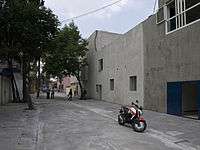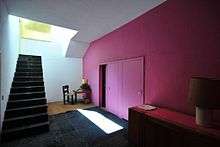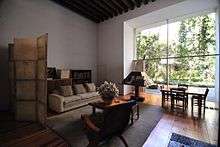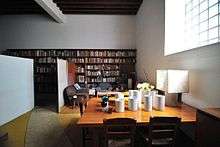Luis Barragán
| Luis Ramiro Barragán Morfín | |
|---|---|
 (1960s) | |
| Born |
March 9, 1902 Guadalajara, Jalisco, Mexico |
| Died |
November 22, 1988 (aged 86) Mexico City, Mexico |
| Nationality | Mexican |
| Occupation | Architect |
| Awards | Pritzker Prize |
| Buildings | Torres de Satélite |
Luis Ramiro Barragán Morfín (March 9, 1902 – November 22, 1988) was a Mexican architect and engineer. His work has influenced contemporary architects through visual and conceptual aspects. Barragán's buildings are frequently visited by international students and professors of architecture. He studied as an engineer in his home town, while undertaking the entirety of additional coursework to obtain the title of architect.[1]
Barragán won the Pritzker Prize, the highest award in architecture, in 1980 and his personal home, the Luis Barragán House and Studio, was declared a World Heritage Site in 2004.
Early life
Barragán was born in Guadalajara in Jalisco, Mexico. Educated as an engineer, he graduated from the Escuela Libre de Ingenieros in Guadalajara in 1923.
After graduation, he travelled through Spain and France. While in France he became aware of the writings of Ferdinand Bac, a German-French writer, designer and artist who Barragán cited throughout his life.[2] In 1931, he again traveled to France with a long stop-over in New York. In this trip he met Mexican mural painter José Clemente Orozco, architectural magazine editors, and Frederick Kiesler. In France he briefly met Le Corbusier and finally visited the gardens realized by Ferdinand Bac. He practiced architecture in Guadalajara from 1927–1936, and in Mexico City thereafter.
Career
His Guadalajara work includes over a dozen private homes in the Colonia Americana area of what is today near downtown Guadalajara. These homes, within walking distance of each other, include Barragán's earliest residential projects. One of his first buildings, Casa Cristo, was restored and houses the state's Architects' Guild.
Remarkable projects
In 1945 he started planning the residential development of Jardines del Pedregal. In 1947 he built his own house and studio in Tacubaya and in 1955 he rebuilt the Convento de las Capuchinas Sacramentarias in Tlalpan, Mexico City, and the plan for Jardines del Bosque in Guadalajara. In 1957 he planned Torres de Satélite (whose iconic towers he created in collaboration with sculptor Mathias Goeritz) and an exclusive residential area, Las Arboledas, a few kilometers away from Ciudad Satélite. In 1964 he designed, alongside architect Juan Sordo Madaleno, the Lomas Verdes residential area, also near the Satélite area, in the municipality of Naucalpan, Estado de México. In 1967 he created one of his best-known works, the San Cristóbal Estates equestrian development in Mexico City.
-
Fuente de los Amantes
-
Casa Gilardi
-
Casa Gilardi
-

Torres de Satélite
Barragán and the Modernist movement

Barragán attended lectures by Le Corbusier and became influenced by European modernism. The buildings he produced in the years after his return to Mexico show the typical clean lines of the Modernist movement. Nonetheless, according to Andrés Casillas (who worked with Barragán), he eventually became entirely convinced that the house should not be "a machine for living." Opposed to functionalism, Barragán strove for an "emotional architecture" claiming that "any work of architecture which does not express serenity is a mistake." Barragán always used raw materials such as stone or wood. He combined them with his incredibly creative use of light.
Honors
Barragán worked for years with little acknowledgement or praise until 1975 when he was honored with a retrospective at the Museum of Modern Art in New York. In 1980, he became the second winner of the Pritzker Architecture Prize. His house and studio, built in 1948 in Mexico City, were listed as a UNESCO World Heritage site in 2004.
Influence

The work of Luis Barragán is often (and misleadingly) quoted in reference to minimalist architecture. John Pawson, in his book Minimum, includes images from some of Barragán's projects. Most architects who do minimalistic architecture do not use color, but the ideas of forms and spaces which Barragán pioneered are still there. There have been several essays written by the Pritzker Prize recipient Alvaro Siza in prefaces to books that make reference to the ideas of Barragán as well.
It has also been proved that Louis Kahn informally consulted Barragán on the space between the buildings of the Salk Institute in La Jolla, California.[3] According to the documents, Kahn's original idea was to place a garden between the buildings; however, Barragán suggested that an open plaza, with only a water feature in between, would better reflect the spirit of the location. This area, possibly designed with Barragán's advice in mind, is arguably the most impressive aspect of the building complex.
Barragán's influence can also be seen in the work of many of Mexico's contemporary architects, such as Ricardo Legorreta.
Legacy
After his death, aged 86, in Mexico City in 1988, two not-for-profit organisations were created to help manage Barragán's legacy.
Fundación de Arquitectura Tapatía which owns (in co-ownership with the Government of the State of Jalisco) Luis Barragán's former private residence: Luis Barragán House and Studio. The house is now a museum which celebrates Barragán and also serves as a conduit between scholars and architects interested in visiting other Barragán buildings in Mexico, including Capilla de las Capuchinas and Casa Prieto López.[4] UNESCO added the Casa Luis Barragán to its World Heritage List in 2004.[5]
The Barragan Foundation is a not-for-profit institution based in Birsfelden, Switzerland. It acquired the professional archives of Luis Barragán in 1995, and the estate of the photographer Armando Salas Portugal documenting Barragán's work in 1997. The Foundation's mission is to spread the knowledge on Luis Barragan's cultural legacy by means of preserving and studying his archives and related historical sources, as well as by assisting further scholarly researches. The Barragan Foundation owns complete rights to the work of Luis Barragán and to the related photos by Armando Salas Portugal.
Important works

All the realized projects by Barragán are located in Mexico.
- Las Arboledas / North of Mexico City (1955–1961)
- House for the architect / Barragán House, Mexico City (1947–48)
- Jardines del Pedregal Subdivision, Mexico City (1945–53)
- Tlalpan Chapel, Tlalpan, Mexico City (1954–60)
- Gálvez House, Mexico City (1955)
- Jardines del Bosque Subdivision, Guadalajara (1955–58)
- Torres de Satélite, Mexico City (1957–58), in collaboration with Mathias Goeritz
- Cuadra San Cristóbal, Los Clubes, Mexico City (1966–68)
- Gilardi House, Mexico City (1975–77)
Luis Barragán House and Studio
Luis Barragán set up his studio in Mexico City, the building is currently a museum, but with tours available only by appointment. The building is from 1948 reflecting Barragán's preferred style, where he lived his whole life. Today is owned by Jalisco and the Arquitectura Tapatía Luis Barragán Foundation. The site became World Heritage Site by UNESCO in 2004.[6]
References
- ↑ Barragán, Luis (2000). Escritos y conversaciones. MADRID: El Croquis. pp. 72–89. ISBN 84-88386-17-6.
- ↑ Tim Street-Porter, Casa Mexicana Stewart, Tabori & Chang (1989) ISBN 1-55670-097-0
- ↑ Salk Institute by Louis I. Kahn at the Wayback Machine (archived September 1, 2000)
- ↑ Casa Luis Barragán website
- ↑ List of Mexican Properties on the World Heritage List
- ↑ "Casa Luis Barragán website". www.casaluisbarragan.org. Retrieved 2015.
External links
| Wikiquote has quotations related to: Luis Barragán |
| Wikimedia Commons has media related to Luis Barragán. |
- Website of the Barragan Foundation (English)
- Luis Barragan's house and studio (Spanish)
- Barragán's Pritzker Prize citation at the Wayback Machine (archived October 29, 2007)
- Artists Rights Society, Barragán's U.S. Copyright Representatives
- Luis Barragan's work (English)
| ||||||
|



